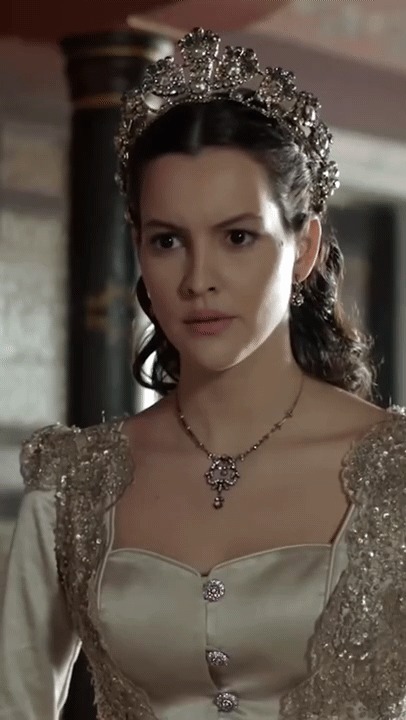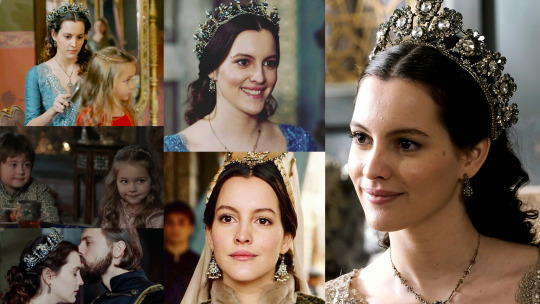#ayse haseki sultan
Explore tagged Tumblr posts
Text





MAKE ME CHOOSE MEME | anon asked - Ayşe and Murad IV or Farya and Murad IV
#magnificent century kosem#muhteşem yüzyıl kösem#magnificent century#perioddramaedit#onlyperioddramas#weloveperioddrama#periodedit#ayse haseki sultan#ayse sultan#haseki ayse sultan#murad iv#*make me choose meme#*ayse sultan
151 notes
·
View notes
Text








#history#magnificent century#muhteşem yüzyıl#ottoman#sultanas#ottoman sultanas#ottoman history#ottoman valide#ayse sultan#haseki ayse sultan#haseki farya sultan#farya sultan#farya bethlen#Ayse haseki sultan#My favorite#muhtesem yuzil kosem#magnificent century kösem
10 notes
·
View notes
Text
Family tree of Ahmed I
Ahmed (1590.04.18. - 1617.11.22.) - Kösem (~1589 - 1651.09.02.)
Mehmed 1605. 03. 08. - 1621. 01. 12.
Ayse ~1606 - 1657
Fatma ~1608 - 1671 (before March)
Hanzade 1609 - 1650.09.
disputed: Selim 1611.06.27.-1611.06.27.
Murad IV 1612.07.27. - 1640.02.08.
Kasim 1614 - 1638.02.17.
Ibrahim 1615.11.05. - 1648.08.18.
Ümmügülsüm ~1616 (possibly) - after 1690
Ahmed (1590.04.18. - 1617.11.22.) - Mahfiruze (~1589 - ~1612)
Osman II 1604.11.03. - 1622.04.20.
disputed: Gevherhan ~1606 - after 1631
disputed: Cihangir 1609
disputed Bayezid 1612. 12. - 1635.07.27.
Ahmed (1590.04.18. - 1617.11.22.) - Unknown concubine(s)
daughter born in 1605 March
Hasan 1612.11.25. - ~1612
Hüseyin 1613.11.14. - 1617
Atike 1614 - 1670
Süleyman 1615 - 1635.07.27.
Abide 1618 - 1648(?)
Orhan (died as a child)
Zahide (died as a child)
Zeynep (died as a child)
Esma (died as a child)
Hatice (died as a child)
Marriages of Ahmed I's daughters:
Gevherhan: - Öküz Kara Mehmed Pasha 1612-1621 * one son (1620) - Topal Recep Pasha 1623-until her own death * Safiye Hanimsultan (~1624-?) - married Mehmed Pasha and was his widow in 1638/9 - married Sadrazam Abaza Siyavuş Pasha 1643-1656
Ayşe: - Nasuh Pasha 1612-1614 - bethroed to Şehit Karakaş Mehmed Pasha 1614 - Müezzinzade Hafiz Ahmed Pasha 1622-1632 * Sultanzade Mustafa Bey 1628-1670 * Sultanzade X - Silahdar Ahmed Pasha 1639-1644 - Voynuk Ahmed Pasha 1645-1649 - Ibşir Mustafa Pasha 1654/5-?
Fatma: - Murtaza Pasha 1622- - Şehid Ali Pasha 1624 - Çatalcali Kapudan Hasan Pasha 1624-1626 * Sultanzade Hasan ~1625 - Kara Mustafa Pasha 1626-? - Sarraç Mustafa Pasha 1629-1630/1 - Kaçanikli Mehmed Pasha 1631 - Canpoladzade Mustafa Pasha 1632-1636 * Sultanzade Hüseyin 1633-1680 * Sultanzade Süleyman 1635-1665 - Koça Yusuf Pasha 1637-1658 * Sultanzade Ömer 1637-after 1670 - Melek Ahmed Pasha 1661-1662 - Kanbur Mustafa Pasha 1663-1666 - Közbekçi Yusuf Pasha 1667
Hanzade - married or bethroed to Murtaza Pasha’s son 1622 - Bayram Agha 1623-1638 * one son - Nakkaş Mustafa Pasha ~1641-until her death * Sultanzade Abdülbaki Bey ~1642-after 1685
Ümmügülsüm - married or bethroed to one pasha in 1626 - Halil Pasha ?-1641/2 - Hersekzade Ahmed Pasha ~1642-1648
Atike - son of Ekmekçizade Ahmed Pasha 1618-? - Sofu Kenan Pasha ~1624-1652 - Doganci Yusuf Pasha 1652-until her death
Theories:
The daughter born in 1605 March being Gevherhan (and then she was not Mahfiruze's daughter).
Hasan being Mahfiruze's not Bayezid and they both died due to complications.
Zeynep being Mahfiruze's daughter as Osman II possibly had a daughter Zeynep (as there are two Zeyneps buried in Ahmed I's türbe), and since Zeynep is not a dynastical name, Osman may named her after his deceased sister. PS: One of the sarcofagies is for a grown woman, which can be a mistake, or maybe Osman's daugter Zeynep reached adulthood (would be strange as until now there is no evidence for an adult sultana called Zeynep during this period).
Identity of Abide: Now it seems that Abide was not a daughter, but an aunt of Ahmed I and so the daughter of Murad III, see more under Murad III's family tree.

#ahmed i#history#ottoman history#ottoman empire#sultanate of women#mahpeyker kösem#kösem#mahfiruze hatun#haseki kösem sultan#ayse sultan#fatma sultan#hanzade sultan#atike sultan#abide sultan#ümmügülsüm sultan#gevherhan sultan#sehzade mehmed#sehzade kasim#sehzade bayezid#sehzade süleyman
29 notes
·
View notes
Text









4 notes
·
View notes
Text



Leyla Feray as Haseki Ayse Sultan Magnificent Century-Kösem Episode 36
#magnificent century: kösem#muhtesem yuzyil: kösem#haseki ayse sultan#leyla feray#turkish drama#stuff:mine#perioddramagif#perioddramasource#perioddramaedit#gifshistorical#mckedit
77 notes
·
View notes
Text


✱ Ayşe Sultan (Leyla Feray) — Magnificent Century: Kosem Ep.45
#magnificent century kosem#ayşe sultan#haseki ayse sultan#magnificent century: kösem#magnificent century#mc: kosem#muhteşem yüzyıl kösem#gifs
30 notes
·
View notes
Text






𝑂𝑡𝑡𝑜𝑚𝑎𝑛 𝐷𝑦𝑛𝑎𝑠𝑡𝑦 𝐻𝑖𝑠𝑡𝑜𝑟𝑦 𝐴𝑝𝑝𝑟𝑒𝑐𝑖𝑎𝑡𝑖𝑜𝑛 𝑀𝑜𝑛𝑡ℎ:
𝑊𝑒𝑒𝑘 2: 𝐻𝑎𝑠𝑘𝑖 𝑆𝑢𝑙𝑡𝑎𝑛𝑠/𝐿𝑒𝑔𝑎𝑙 𝑊𝑖𝑣𝑒𝑠
𝐷𝑎𝑦 12: 𝐴𝑦𝑠𝑒 𝑆𝑢𝑙𝑡𝑎𝑛, 𝐻𝑎𝑠𝑒𝑘𝑖 𝐴𝑦𝑠𝑒 𝑆𝑢𝑙𝑡𝑎𝑛
#ayse sultan#haseki ayse sultan#muhtesem yuzil kosem#magnificent century: kosem#ottoman dynasty history appreciation month:week 2
36 notes
·
View notes
Text
And for some reason, Hürrem gets the blame for it. Just like she got the blame for his execution even though all she did was reveal what Ibrahim had said and done.
It's interesting that the first time Ayşe Hafsa collapses, it's because Hürrem told her what Ibrahim did to Leo. And then Ayşe Hafsa dies because Hürrem told her that Ibrahin had cheated on Hatice. Both times, it's the revelation that Ibrahim was a much worse person than she had thought that does it.
14 notes
·
View notes
Text
Long Shall She Reign
A Muhtesem Yuzyil (Magnifcent Century) inspired HOTD fanfic
Warnings: This fic includes dubcon, pregnancy, childbirth, child loss, miscarriage, stillborn birth, character death, violence and inc3st(Targcest. Uncle/Niece), Underage Sex(mentioned), Brothels/Sex Workers Tags might be added as the fic goes on. Don't like, don't read.
Aemond Targaryen x Velaryon Strong!Reader (Aemond x Niece OC)

Face claim: Merve Boluğur
Nurisa Sultan(AFAB OC Strong! ) Also known as Princess Visenya Velaryon, Visenya Waters, Nurisa Hatun. Eventully known as: Her Grace the King's Mother, Valide Nurisa Sultan
**Info on Character and slight, minor(but essential) spoilers ahead
Backstory:
Born as Princess Visenya Velaryon, daughter of Princess Rhaenyra Targaryen and Ser Laenor Velaryon, twin to Prince Jacaerys Velaryon. Her dragon egg never hatched, nor did she ever have the opportunity to claim a dragon. As a result, she grew close to her half-uncle, Prince Aemond Targaryen, as they both shared the same predicament. Princess Visenya was a cherished part of King’s Landing during her early years, known to bring smiles to even the sternest members of the King’s Guard (except Ser Criston Cole, but his opinion was one that no one cared for, given he was a right c*nt. Despite the rumors surrounding her parentage, coupled with her lack of a dragon, she remained a carefree and intelligent child. It was said she mastered both Old Valyrian and Zarahani. That was, until the Driftmark Incident.
After leaving King’s Landing with her parents and siblings, she lived at Dragonstone until the funeral of her aunt, Lady Laena Velaryon. She attended the funeral as expected and retired that night to the chambers assigned to her. When her brothers and cousins woke her from her sleep to find her late mother’s dragon, she reluctantly joined them, slipping her dagger into her sleeve.
After the fateful encounter between her uncle, brothers, and cousins, her life was changed forever. Stripped of her title and name, she became Visenya Waters, disowned, and promptly sent to live in King’s Landing, all by Otto Hightower’s decree. But that was not the end of Visenya... not by a long shot.
At the age of eight, she was sent to a brothel. When she came of age, she entertained the advances of strangers and known men alike. Due to mysterious circumstances, she was captured, enslaved, and sold to the Sultanate of Zarahan. Entering the harem while pregnant and scarred, she was taken in by the Valide Sah Sultan. After giving birth to her son, Aethan, and later to Ayse Sultan and Şehzade Murad, while raising her stepson, Şehzade Bayezid, Nurisa climbed the ranks, eventually becoming the Haseki and Legal Wife of Sultan Ahmed. Through multiple trials and losses, the most significant being the death of her son, Aethan, and the deaths of her other children in the cradle or womb, along with the passing of the Valide and, eventually, Sultan Ahmed, Nurisa became Valide Sultan to her stepson, Bayezid, and amassed power and the love of the people. Now, with her children, Ayse and Murad, halfway across the world—in Westeros of all places—Nurisa is forced to return and confront the family who abandoned her.
She left Westeros a slave and a bastard, and returned as Valide-Kabir Naib-Sultanate Nurisa Sultan, Queen Mother and (former) Regent of Zarahan. Westeros, beware, for hell hath no fury like a woman scorned, especially not Nurisa.
For what is Nurisa to do when she discovers her son is alive? What is she to do when she finds herself in Westeros once more? What is she to do when she encounters a certain One-Eyed Prince?
What any sensible woman would do.
Revenge.
#hotd#hotd fanfic#hotd fandom#hotd oc#Velaryon Strong OC#aemond x niece#aemond targaryen x fem!oc#aemond targaryen x strong!oc#house targaryen#muhtesem yuzyil#or atleast muhtesem yuzyil inspired#Muhteşem Yüzyıl
24 notes
·
View notes
Text
Ayşe was born around 1613, she was greek. With permission of Kösem Sultan, Murad IV rewarded her with Haseki Sultan title. In 1633, Murad raises her salary to 2000 aspers a day. The number and identity of her childern has not been confirmed. Angelo Alessandri, a secretary of venetian ambassador wrote about her that she was of Greek origin. According to him, although she was beautiful, she was not as beautiful in spirit as her mother- in law Kösem. Apparently, Ayse was a woman who wasted her money more for greed then generosity. Murad was known for loving Ayşe. He treated her like a queen and she behaved like a queen.Ayşe accompanied Murad IV to Baghdad Campaign. Which was unusal since the incident with Bayezid I amd Olivera Lazarevic when they were captured by Timur. According to austrian historian Joseph von Hammer- Purgstall, Ayşe witnessed the entire campaign.Murad IV passed away in February 1640. We know that Kaya Esmehan's mother came into conflict with Kösem Sultan because Kösem wanted to marry the little girl Kaya to Melek Ahmed Pasha, who was about the same age as Kösem, and she succeeded in doing so. Ayse's salary was cut to just 100 aspers per day. This could just be a coincidence or a hint that Ayse was Kaya's mother. Ayşe passed away in 1679/1680.

youtube

#valide sultan#youtube#ayşesultan#hasekiayşesultan#ottoman history#histoire#history#hasekisultan#sultanmurad#kösemsultan
16 notes
·
View notes
Text








#history#magnificent century#muhteşem yüzyıl#ottoman#sultanas#ottoman sultanas#ottoman history#ottoman valide#haseki ayse sultan#Ayse sultan#Sultana ayse#My favorite#muhtesem yuzil kosem#magnificent century kösem
28 notes
·
View notes
Text
Portrait of Murad IV's consorts / IV. Murad ágyasainak portréi
Haseki Ayşe Sultan
The Haseki
Ayşe Sultan was Murad’s favorite, dominating his reign throughout. Ayşe may have been roughly the same age as Murad, born around 1612. We know that her origin was Greek, for the ambassadors often likened her to her Greek mother-in-law, Kösem Sultan. Ayşe appears in harem records from 1628, so presumably, it was at this time that she became Murad's concubine. Unfortunately, we do not know who Ayşe’s children were and how many children she had, her only known daughter was Esmehan Kaya, who was born in 1633.
We do not know exactly when Ayşe became Haseki Sultan, but we can assume the date 1632. For from this year we have an ambassador report according to which Murad asked his mother for approval to raise the mother of his most recently born daughter to the Haseki rank. Unfortunately, we do not know which girl was born in 1632. Hanzade was born in 1631 or 1632, and a girl named Esmehan was born and die surely before 1633, but we do not know who was the mother of these sultanas. It is also possible that we erroneously postpone the birth of Esmehan Kaya to 1633. However, since Ayşe held the rank of Haseki and dominated throughout Murad's reign, we can assume that she had several children in addition to Kaya, especially boys. So it is simply possible that she gave birth to a child in 1632.
Not much of Ayşe's personality is known. In 1637, the Venetian ambassadors' secretary Angelo Alessandrini spoke of Ayşe as a woman of outstanding beauty, but in spirit, she was not in the least like the Valide Sultan, Kösem. Nonetheless, according to Alessandrini, the sultan holds her in high esteem and treats her like a queen, and Ayşe also strives to behave like a real queen. However, according to the secretary, she has no chance and in vain she tries to imitate the Valide Sultan in her clothes, jewelry, and number of servants, she can never reach her. Alessandrini reveals a lot about Ayşe with this short description, but it is important to keep in mind that Alessandrini and the ambassador he worked with were extremely loyal admirers of the great Valide Sultan, Kösem, so it is not surprising that no one could reach her in their opinions.
The strong bond between Ayşe and Murad is well exemplified by the fact that Murad took Ayşe with him on his campaign of Yerevan. This was exceptional, for the sultans had not taken their wives and favorite concubines with them for centuries. Bayezid I and his wife fell into the captivity of Timur Lenk together and, according to legend, Bayezid was tortured by Timur with raping and humiliating his wife in front of Bayezid. There is also a known case from Selim I's time when, during a campaign against the Safavids, Selim captured one of the shah's favorite concubines (or his wife), who he then married to an unimportant Ottoman official. Aware of such risks, most sultans did not take their wives with them. Some believe that Ayşe gave birth to a son named Aleaddin during this campaign, but this is probably the result of a misunderstood. Prince Aleaddin was indeed born in 1635 during the campaign, but he was born in Istanbul, so Ayşe, who was on the campaign, could hardly have been his mother, and Murad could hardly have allowed his pregnant concubine to accompany him to the campaign.
Perhaps precisely because Ayşe was with Murad throughout the campaign, many blame Ayşe for the execution of Murad’s younger brothers. After returning from the campaign, Murad killed his two half-brothers, Bayezid and Suleiman. However, there is no evidence that Ayşe ever tried to turn Murad against the princes. After the campaign, several eyewitnesses described Ayşe’s return to Istanbul as a very magnificent event. For Ayşe, this was probably one of the last magnificent moments, as soon Murad's health deteriorated, his sons died and a new concubine emerged, whom Murad also raised to the rank of Haseki and who was paid a higher salary than Ayşe.

The Widow Sultana
After the death of Murad in 1640, she moved to the Old Palace with the other concubines of Murad and with her child or children. Her relationship with Kösem Sultan was probably never very good and close, but it soon reached a low point. Esmehan Kaya entered an age to be slowly married off in the mid-1640s. The selection of the husband was the responsibility of the Sultan and the mother of the child. The Valide also had a word but she was not the one to decide. We know, for example, that even though Nurbanu wanted to marry one of her grandchildren to a certain man, Safiye (the girl’s mother) prevented this. That is why there was nothing strange about Ayşe choosing a husband for Esmehan Kaya herself. The husband candidate was not particularly politically significant anyway. He was one of Murad's former swordbearers, to whom Murad himself promised Kaya before he died. Kösem, however, wanted one of her own trusted men to be Kaya’s husband, a pasha who was loyal to her already and who she could permanently chain to herself with marriage.
So Ayşe and Kösem were tense to each other, but it is not known in detail how the war between the two women took place. Some say Ayşe tried to seek the help of Sultan Ibrahim, who, however, wanted to take advantage of the situation and wanted Ayşe for himself. In the end, this did not happen, so Kösem and her chosen one, Melek Ahmed Pasha won. Kaya and Kösem were close to each other, she was Kösem's favorite grandchild, this is why it is strange that Kösem forced her to marry Melek Ahmed despite Kaya's own will. The fact that Kösem forced Kaya, a barely 13-year-old girl, to consummate the marriage with a pasha (who in age was like Kaya's own grandfather) complicating matters further. It was especially extreme because Kaya threatened the pasha with a dagger to leave her alone and the pasha accepted this. So both of the parties were totally fine with it, but Kösem still did not let it happen. Maybe Kösem thought that without consummating the marriage Ayşe could have tried to invalidate it.
Perhaps the former events also are related to the fact that instead of Ayşe's previous high salary (2000 aspers per day), in the Old Palace she received only 100-200 aspers per day for the rest of her life, regardless of whether Valide and Haseki Sultanas could keep their original salaries even in the Old Palace. Ayşe disappears from the harem records in 1680, suggesting that she died in either 1679 or 1680. During her relatively long life, she could see the reign of three sultans, reached heaven as Murad’s favorite, and reached hell as a mother. In addition to Esmehan Kaya, she certainly had sons and perhaps other daughters who all died as children. Her only child who reached adulthood, Esmehan Kaya, also died before Ayşe in 1658.

The second Haseki Sultan
Not much is known about her, her name, origin, the identity of her children are all obscured. All we know is that after Murad’s campaign in Yerevan, she was elevated to the rank of Haseki, certainly because she gave birth to a son. Maybe she was the mother of Prince Aleaddin, but more likely she had given birth to her child later, perhaps she was the mother of a prince who was born in 1638, perhaps of another unknown child. The second Haseki started her career with a daily salary of 2571 aspers, which was higher than the salary of Ayşe with 2000 aspers. We do not know the reason for this, but barely seven months later Murad also reduced her salary to 2,000 aspers. Perhaps the reason for the extremely high salary could have been that she became pregnant (or gave birth to a son) when all of Murad's sons died and by the time Prince Kasim (his brother) had already been executed? A heir was more urgent at this time than ever before, so it makes sense for Murad to give the concubine an outstanding allowance for the news of pregnancy or childbirth. Then, seven months later, when the Haseki lost her child or gave birth to a daughter, Murad reduced her salary to the level of Ayşe's, who also lost her sons.
Regarding her origin, the possibility arises that she was Sicilian. Jean-Baptiste Tavernier reports that Murad spent a particularly large amount of time in the Yerevan Pavilion with a Sicilian woman who he loved very much and who, in addition to her beautiful appearance, was a truly generous creature, so Murad never denied anything from her. According to Tavernier, she was a Sicilian noblewoman who was captured at sea and then gifted to the Sultan by Algir's beylerbey. Maybe the story is true, maybe not. Maybe it's about the second Haseki, maybe someone else.
With Murad’s death, the second Haseki disappears from the harem records forever, for which there are only two explanations (especially knowing that Ayşe appears precisely in the same register until her own death). The second Haseki maybe died shortly before Murad or was married off. The latter would not be unusual, since the widows of the sultans were often married off if they were childless or only had daughters. Since it is quite probable that the second Haseki lost her child, it was a logical solution to marry her off. Since she did not live in the harem anymore and is not on the registers, we do not know when she died.

Sanavber Hatun
Sanavber was a member of Murad's harem, of whom we know that she had a foundation which she established in 1628. The date of 1628 makes it probable that Sanavber may not have been Murad's concubine as Murad’s first child was born in 1627, so while it is possible for his mother to be Sanavber, it is unlikely that a young and inexperienced mother around the age of 15 would be allowed (and has the money) to establish a foundation. It is more likely that Sanavber was a high-ranking harem servant who owed her privileged status to either Murad or to Kösem Sultan. What makes her particularly interesting is that the documents of her foundation refer to her as “Sanavber bint Abdülmennan,” which is not the usual reference to converted slaves but a reference to a Muslim woman. Sanavber, then, may have been a high-ranking, free Muslim woman who perhaps belonged to Murad’s harem as a poet or associate, such as Hubbi Hatun was in the harem Selim II and Murad III?

Emirgün's sister
According to some, when Emirgün surrendered and handed over the castle of Yerevan to Sultan Murad in 1635, he presented his sister to the sultan. Legend has it that the woman was so beautiful that all of Murad's concubines faded beside her. Others say Murad never made Emirgün's sister his concubine, but there are also those who say Emirgün never gave his sister to Murad. Either way, the woman never entered Murad’s Istanbul harem.
Rosana
Rosana is probably a legend rather than Murad’s real concubine. Legend has it that Rosana was tall, blonde, and very light-skinned, but very bad in personality, so much so that Murad was afraid of her. Rosana was jealous of everything and everyone, hating Murad's other consorts, his younger brothers. Some go so far that it was Rosana, who executed the sultan's younger brothers on behalf of Murad. When one of Murad’s sisters realized this, she accused Rosana, but Murad didn’t believe her sister and became so angry that he killed her with a hammer. Finally, Kösem proved that Rosana was the murderer of the princes, by the time Murad himself stabbed the woman with a dagger, but the sultan never loved another woman later. I think it’s clear to everyone that this is more of a fairy tale than a real story. Never does a harem register or any ambassador from the period mention Rosana.

Used sources: C. Finkel - Osman's Dream: The Story of the Ottoman Empire; L. Peirce - The imperial harem; G. Piterberg - An Ottoman Tragedy, History and Historiography at Play; Öztuna - Devletler ve Hanedanlar; Uluçay - Padişahların Kadınları ve Kızları; F. Davis - The Palace of Topkapi in Istanbul; Y. Öztuna - Genç Osman ve IV. Murad; G. Junne - The black eunuchs of the Ottoman Empire; R. Dankoff - An Ottoman Mentality: The World of Evliya Çelebi; R. Murphey - ‘The Functioning of the Ottoman Army under Murad IV (1623–1639/1032–1049):Key to Understanding of the Relationship Between Center and Periphery
* * *
Haseki Ayşe Sultan
A Haszeki
Ayşe szultána volt Murad kedvence, aki uralkodását végig dominálta. Ayşe valószínűleg Muraddal nagyjából egy idős lehetett, 1612 körül születhetett. Származását tekintve tudjuk, hogy görög volt, ugyanis a követek gyakran hasonlították szintén görög anyósához, Köszem szultánához. Ayşe 1628-tól tűnik fel a háremjegyzőkönyvekben, így feltehetőleg nagyjából ekkor lett Murad ágyasa. Sajnos nem tudjuk, hogy kik voltak Ayşe gyermekei és hogy hány gyermeke volt, egyetlen ismert lánya Esmehan Kaya, aki 1633-ban született.
Nem pontosan tudjuk, hogy Ayşe mikor lett Haszeki szultána, azonban feltételezhetjük az 1632-es dátumot. Ugyanis ebből az évből maradt ránk egy követi beszámoló, mely szerint Murad anyja jóváhagyását kérte, hogy Haszeki rangra emelje (vagy feleségül vegye) legújabban született lányának anyját. Sajnos nem áll rendelekzésünkre, hogy melyik lány született 1632-ben. Hanzade 1631-ben vagy 1632-ben született, egy Esmehan nevű lány pedig tudottan 1633 előtt, ám nem tudjuk ki volt ezen szultánák édesanyja. Az is lehet, hogy Esmehan Kaya születését tesszük tévesen 1633-ra. Mivel azonban Ayşe a Haszeki rangot viselte és Murad uralma alatt végig dominált, feltételezhetjük, hogy több gyermeke volt Kaya mellett, különös tekintettel fiúkra is.
Ayşe személyiségéről nem sok maradt fenn. Angelo Alessandrini velencei titkár 1637-ben úgy beszélt Ayşéről, mint kiemelkedő szépségű nőről, aki azonban lélekben a legkevésbé sem olyan, mint a Valide szultána, Köszem. Ettől függetlenül Alessandrini szerint a szultán nagy becsben tartja és királynőként bánik vele, Ayşe pedig igyekszik úgy is viselkedni, mint egy valódi királynő. Erre azonban a titkár szerint esélye sincs és hiába próbálja ruháiban, ékszereiben és szolgálói számában is utánozni a Valide szultánát, sosem érhet fel hozzá. Alessandrini ezzel a rövid leírással is sokat elárul Ayşéról, azonban fontos észben tartanunk, hogy Alessandirini és a követ, akinek dolgozott, Köszem végletekig hűséges csodálói voltak, így nem meglepő, ha számukra senki nem érhetett fel a nagy Valide szultánához.
Az Ayşe és Murad között lévő erős köteléket jól példázza, hogy Murad magával vitte Ayşét yerevani hadjáratára is. Ez kivételes volt, ugyanis a szultánok évszázadok óta nem vitték magukkal feleségeiket és kedvenc ágyasaikat a hadjáratokra. I. Bayezid és felesége ugyanis együtt estek Timur Lenk fogságába és a legendák szerint Bayezidet úgy kínozta Timur, hogy feleségét gyalázta és alázta meg előtte. Emellett I. Szelim idejéből is ismert egy eset, mikor egy szafavidák elleni hadjárat során Szelim fogjul ejtette a sah egyik kedvenc ágyasát (vagy feleségét), akit aztán rangol alul házasított ki egy oszmán tisztviselőhöz. Ilyen kockázatok ismeretében a legtöbb szultán nem vitte magával feleségeit, nem úgy Murad. Egyesek úgy tartják, hogy Ayşe a hadjáraton adott életet Aleaddin nevű fiuknak, ez azonban valószínűleg egy félrefordítás eredménye csupán. Aleaddin herceg valóban 1635-ben született a hadjárat ideje alatt, azonban Isztambulban jött világra, így aligha lehetett a hadjáraton tartózkodó Ayşe az édesanyja és Murad aligha engedte volna várandós ágyasának, hogy elkísérje a hadjáratra.
Talán épp amiatt, mert Ayşe végig Murad mellett volt a hadjáraton, sokan okolják Ayşét Murad öccseinek kivégeztetése miatt. Murad ugyanis a hadjáratról visszatérve ölette meg két féltestvérét, Bayezidet és Szulejmánt. Azonban nincs arra utaló bizonyíték, hogy Ayşe valaha is a hercegek ellen próbálta volna fordítani Muradot. A hadjárat után több szemtanú is leírta Ayşe Isztambulba való visszatérését, mint egy igen pompás eseményt. Ayşét pedig nemsokkal később Murad is követte. Ayşe számára valószínűleg ez volt az egyik utolsó fényűző pillanat, hiszen hamarosan Murad egészsége egyre rosszabbra fordult, fiai hamarosan meghaltak és hamarosan előkerült egy új ágyas, akit Murad szintén Haszeki rangra emelt és akinek magasabb fizetést adott, mint Ayşének.

Az özvegy szultána
Ayşe Murad 1640-es halála után a Régi Palotába költözött Murad többi ágyasával és gyermekével vagy gyermekeivel együtt. Viszonya feltehetőleg sosem volt túl jó és közeli Köszem szultánával, de hamarosan elérte a mélypontot. Esmehan Kaya az 1640-es évek közepére lassan kiházasítandó korba került. A férj kiválasztása a mindenkori szultán és a gyermek édesanyjának feladata volt. A Valide szultánának minden bizonnyal szintén lehetett szava, ám nem ő döntött. Tudjuk például, hogy Nurbanu hiába szerette volna egyik unokáját egy bizonyos férfihoz adni feleségül, Safiye (a lány anyja) ezt megakadályozta. Épp ezért nem volt abban semmi furcsa, hogy Ayşe maga válasszon férjet Esmehan Kaya számára. A férjjelölt egyébként nem volt különösen jelentős politikai szempontból. Murad egyik korábbi fegyverhordozója volt, akinek még maga Murad ígérte oda Kayát, mielőtt meghalt volna. Köszem szultána azonban a saját emberei közül akart valakit Kaya férjéül, egy olyan pasát, aki hűséges hozzá és akit végleg magához láncolhat a házassággal.
Ayşe és Köszem egymásnak feszültek tehát, de nem tudni részletekbe menően, hogyan zajlott a két nő közötti háború. Egyesek szerint Ayşe igyekezett Ibrahim szultán segítségét kérni, aki azonban ki akarta használni a helyzetet és magának akarta Ayşét. Végül ez nem történt meg, így győzött Köszem és a választottja Melek Ahmed Pasa. Kaya és Köszem különösen közel álltak egymáshoz, ő volt Köszem kedvence, emiatt is különös, hogy Köszem a lány kérése ellenére is hozzákényszerítette a saját választottjához. Tovább bonyolítja a helyzetet a tény, hogy Köszem kényszerítette az alig 13 éves Kayát és a nagyapja korú pasát, hogy elhálják a nászt, miután ezt Kaya megtagadta a pasa pedig egyetértett vele. Talán Köszem motivációja az volt, hogy elhálás nélkül Ayşe megpróbálhatta volna érvényteleníteni azt.
Talán az előbbi eseményeknek is köze lehet ahhoz, hogy Ayşe korábbi magas fizetése (napi 2000 asper) helyett a Régi Palotában csupán 100-200 asperes napi fizetést kapott élete végéig, függetlenül attól, hogy a Valide és Haszeki rangot viselők nőknek Régi Palotába költözés után sem volt szokás csökkenteni a fizetését. Ayşe 1680-ban tűnik el a hárem jegyzőkönyvekből, ami arra enged következtetni, hogy vagy 1679-ben vagy 1680-ban halt meg. Viszonylag hosszú élete során három szultán uralkodását is láthatta, megjárta a mennyet Murad kedvenceként és a poklot anyaként. Esmehan Kaya mellett egészen biztosan voltak fiai és talán más lányai is, akik gyermekként mind meghaltak. Egyetlen felnőttkort megérő gyermeke, Esmehan Kaya is Ayşe előtt halt meg 1658-ban.

A második Haszeki szultána
Nem sokat tudni róla, neve, származása, gyermekeinek kiléte mind homályba vész. Annyit tudunk, hogy Murad yerevani hadjárata után lett Haszeki rangra emelve, minden bizonnyal azért, mert életet adott egy fiúnak. Talán ő volt Aleaddin herceg anyja, ám ennél valószínűbb, hogy még később hozta világra gyermekét, talán ő volt egy 1638-ban világra jött herceg anyja, talán más ismeretlen gyermeké. A második Haszeki 2571 asperes napi fizetéssel kezdte meg pályafutását, amely magasabb volt, mint Ayşe 2000 asperes fizetése. Ennek okát nem tudjuk, azonban alig hét hónappal később Murad lecsökkentette az ő fizetését is 2000 asperre. Talán az extrém magas fizetés oka lehetett, hogy akkor lett terhes (vagy szült fiút), mikor Murad összes addig élő fia elhunyt már és amikorra talán már Kasim herceget (édesöccsét) is kivégeztette? Ekkor sürgősebb volt egy örökös, mint bármikor máskor, így logikus, hogy a terhesség vagy szülés hírére Murad kimagasló juttatást adjon az ágyasnak. Aztán hét hónappal később, amikor a Haszeki elvesztette gyermekét vagy leányt szült fizetését Murad lecsökkentette a szintén fiait elvesztő Ayşe szintjére.
Származásával kapcsolatban felvetődik annak lehetősége, hogy szicíliai volt. Jean-Baptiste Tavernier beszámol arról, hogy Murad különösen sok időt töltött a Yerevan Pavilonban egy szicíliai nővel, akit nagyon szeretett és aki gyönyörű külseje mellett igazán nagylelkű teremtés volt, így Murad sosem tagadott meg tőle semmit. Tavernier szerint nemesi származású szicíliai nő volt, akit a tengeren ejtettek fogságba, majd Algír beglerbégje ajándékozta a szultánnak. Talán igaz a történet, talán nem. Talán a második Haszekiről van szó, talán másról.
Murad halálával a második Haszeki örökre eltűnik a hárem jegyzékből, melyre csak két magyarázat lehet (különösen annak ismeretében, hogy Ayşe precízen megjelenik saját haláláig ugyanebben a jegyzőkönyvben): a második Haszeki is elhunyt Murad előtt nemsokkal vagy kiházasították. Utóbbi nem lenne szokatlan, hiszen a szultánok özvegyeit gyakran házasították ki, ha azok gyermektelenek voltak vagy csak lányaik voltak. Mivel elég valószínű, hogy a második Haszeki elvesztette gyermekét, logikus megoldás volt kiházasítása. Mivel nem a háremben élt és nem szerepel a jegyőzkönyvekben nem tudjuk mikor halt meg.

Sanavber Hatun
Sanavber, Murad háremének egyik tagja volt, akiről annyit tudunk, hogy a nevével ellátva létezett egy alapítvány, melyet 1628-ban hozott létre. Az 1628-as dátum valószínűsíti, hogy Sanavber talán nem Murad ágyasa volt. Murad első gyermeke 1627-ben jött világra, így bár lehetséges, hogy az ő anyja legyen Sanavber, ám valószínűtlen, hogy egy 15 év körüli, friss és tapasztalatlan anyának engedik (és van rá pénze), hogy alapítványt hozzon létre. Valószínűbb, hogy Sanavber egy magasrangú hárem szolgáló volt, aki kiemelt státuszát vagy Köszem szultánának vagy Muradnak köszönhette. Különösen érdekessé teszi helyzetét, hogy a dokumentumok úgy hivatkoznak rá, mint “Sanavber bint Abdülmennan”, ami nem az áttért rabszolgák szokásos hivatkozása hanem egy muszlim nő hivatkozása. Sanavber tehát lehet, hogy egy magas rangú, szabad muszlim nő volt, aki talán költőként vagy társalkodóként tartozott Murad háremébe, mint például Hubbi Hatun II. Szelim és III. Murad háremébe?

Emirgün testvére
Egyesek szerint mikor Emirgün megadta magát és átadta Yerevan várát Murad szultánnak 1635-ben, akkor húgát a szultánnak ajándékozta. A legendák szerint a nő olyan gyönyörű volt, hogy mellette Murad minden ágyasa elhalványult. Mások szerint Murad sosem tette ágyasává Emirgün testvérét, de olyanok is vannak, akik szerint Emirgün sosem adta oda húgát Muradnak. Akárhogy is, a nő sosem lépett be Murad isztambuli háremében.
Rosana
Rosana valószínűleg inkább egy legenda, mintsem valódi ágyasa Muradnak. A legendák szerint Rosana magas volt, szőke és nagyon világos bőrű, azonban nagyon rossz természetű, olyannyira, hogy Murad is félt tőle. Rosana mindenre és mindenkire féltékeny volt, gyűlölte Murad öccseit. Egyesek odáig mennek, hogy Rosana volt az, aki Murad nevében kivégeztette a szultán öccseit. Mikor Murad egyik húga rájött erre, megvádolta Rosanát Murad előtt, aki nem hitt testvérének és egy kalapáccsal megölte őt. Végül Köszem bizonyította, hogy Rosana volt a hercegek gyilkosa, mire Murad maga szúrte le a nőt egy tőrrel, ám a szultán később sosem szeretett más nőt. Azt hiszem mindenki számára egyértelmű, hogy ez inkább egy mese, mint valódi történet. Soha egy hárem jegyzék sem említi Rosanat és egy körabeli követ sem.

Felhasznált források: C. Finkel - Osman's Dream: The Story of the Ottoman Empire; L. Peirce - The imperial harem; G. Piterberg - An Ottoman Tragedy, History and Historiography at Play; Öztuna - Devletler ve Hanedanlar; Uluçay - Padişahların Kadınları ve Kızları; F. Davis - The Palace of Topkapi in Istanbul; Y. Öztuna - Genç Osman ve IV. Murad; G. Junne - The black eunuchs of the Ottoman Empire; R. Dankoff - An Ottoman Mentality: The World of Evliya Çelebi; R. Murphey - ‘The Functioning of the Ottoman Army under Murad IV (1623–1639/1032–1049):Key to Understanding of the Relationship Between Center and Periphery
#haseki ayşe#Murad IV#sanavber#rosana#farya bethlen#Kösem sultan#kösem#mahpeyker kösem#esmehan kaya#ismihan kaya#kaya sultan#ayse#ayse haseki sultan#haseki
58 notes
·
View notes
Note
Any unpopular opinions?
Ayse haseki sultan was a shitty person and I don’t think she deserves the pedestal she’s put on.
#unpopular opinion#awkward-sultana#Anonymous#Ayşe Sultan#Ayse Sultan#Ayse haseki sultan#Ayşe haseki sultan#kosemedit#magnificent century kosem#Muhteşem Yüzyıl Kösem#Magnificent Century: Kösem#muhtesem yuzyil kosem#mck#mc: kosem#my: kosem
13 notes
·
View notes
Photo


♕ “Murad is behaving strangely, he leaves at night and no one knows where he goes… except you.”
#kosemedit#perioddramaedit#magnificent century kosem#muhtesem yuzil kosem#ayse haseki sultan#gifs*#i miss her#remember when the writers tried to ruin her character#but everybody ended up loving her anyway?#good times
163 notes
·
View notes
Text

#new muse#my favorite picture#leyla feray#ayse haseki sultan#ayse sultan#ayselove#ayşe haseki sultan#ayşe sultan#muhteşem yüzyıl kösem#magnificent century kosem
24 notes
·
View notes
Photo









ayşe haseki sultan’s pastel blue gown from s02e32
(requested by @kinda-real-awkward)
#perioddramaedit#kosemedit#ayse haseki sultan#magnificent century kosem#muhteşem yüzyıl kösem#mck: s02e32#*requested
2K notes
·
View notes